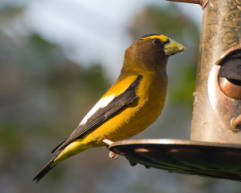 Purdue University - Extension - Forestry and Natural Resources
Purdue University - Extension - Forestry and Natural Resources
Got Nature? Blog

Evening Grosbeaks are common winter visitors to bird feeders. (Photo by U.S. Fish & Wildlife Service)
When the temperatures drop and the snow falls, we often turn our attention to what we can do to help the wildlife which calls our yards home. In most cases, professional wildlife biologists don’t recommend the feeding of wildlife. We instead focus on providing structural elements that provide food, water and cover to provide the necessary wildlife habitat. However, bird feeding, and particularly winter bird feeding, is an exception. It should not replace providing other elements of wildlife habitat in your backyard.
What can you do? Like most things, it comes down to how much time you have and what you want to spend. There are a couple good tips you can follow to get the best results for your investment.
Food type – bird seed mixes can contain “fillers” that is relatively inexpensive and can attract undesirable species of birds. Different bird species have different needs. If you can, offer a single type of bird food in a single feeder. Mixes are ok, but birds will sift through what they don’t want to find what they do want. If you have to pick one to start, offer black-oil sunflower. It is a high-quality food that is attractive to a variety of bird species. Suet is a favorite food of woodpeckers and nuthatches. Commercially available suet cakes also contain seeds and nuts that other birds will consume.
Feeder type – different bird species are adapted to feeding in different ways and locations (e.g., for example). Better designed feeders are sturdy, easy to clean, and easy to fill. Covered platform feeders keep seeds protected from moisture and is attractive for many species of birds (you can fill with black-oil sunflowers). Even though they are covered, the tray should have drainage holes. Tube feeders attract different species of birds such as finches. The small perches and access holes for feeding exclude larger birds such as grackles and blue jays. Open trays close to the ground are good for jays and doves. However, they offer no protection from moisture or squirrels.
Non-targets – squirrels are a common problem at feeders. Metal or plastic baffles or cones can exclude squirrels from many feeders that are mounted on poles or hung from a wire. Some feeders are enclosed in wire cages that prevent squirrels from reaching the seed but still allow access to smaller birds. Starlings are a common problem at suet feeders. However, their feet are relatively week. Suet feeders that only allow access from the bottom prevent starlings access but still allow access for woodpeckers and nuthatches.
Placement – feeders should be placed in areas where you can observe them. Placing them within a few feet of cover can provide “rest” areas for birds to wait their turn. However, low and shrubby ground cover can provide hiding places for domestic cats to ambush birds. Avoid placing feeders in these locations. In extreme cases, you may have to fence off feeding areas to exclude cats.
These are just a few tips to get you started. There are many good resources for feeding songbirds and attracting wildlife to your backyard.
Publications
– Henderson, C.L. 1995. Wild about birds: the DNR bird feeding guide. Minnesota Department of Natural Resources, St. Paul, MN.
– For the Birds, U.S. Fish and Wildlife Service
Resources
– Cornell Lab or Ornithology, Cornell University
– Audubon Society, Bird Feeding Tips
Brian MacGowan, Wildlife Extension Specialist
Purdue Forestry and Natural Resources

Recent Posts
- Hardwood Tree Log and Lumber Quality Workshop
Posted: May 10, 2024 in Forestry, Forests and Street Trees, How To, Woodlands - Take Your Turkey Fun Further – Wild Bulletin
Posted: May 9, 2024 in Forestry, How To, Wildlife - Paddle for Data – Wild Bulletin
Posted: in Aquaculture/Fish, Great Lakes, Ponds, Wildlife - IISG Adds New Water Safety Videos
Posted: May 8, 2024 in Aquaculture/Fish, Aquatic/Aquaculture Resources, Community Development, Great Lakes, Wildlife - Invasive Bradford-Callery Pear: Why it is so detrimental and what to plant instead
Posted: in Forests and Street Trees, How To, Invasive Plant Species, Urban Forestry - Trees and Storms – Mitigating the Damage
Posted: May 7, 2024 in How To, Urban Forestry - New Indiana Woodland Steward Newsletter, Your Forest and Wildlife Resource
Posted: in Timber Marketing, Wildlife, Woodlands - Farmers Helping Hellbenders RCPP Program Accepting Applications
Posted: May 1, 2024 in Aquaculture/Fish, Forestry, How To, Wildlife, Woodlands - Extension Specialist Brian MacGowan Receives Hoosier Wildlife Award
Posted: in Forestry, Wildlife - MyDNR – First positive case of chronic wasting disease in Indiana
Posted: April 29, 2024 in Alert, Disease, How To, Safety, Wildlife
Archives
Categories
- Alert
- Aquaculture/Fish
- Aquatic/Aquaculture Resources
- Ask the Expert
- Christmas Trees
- Community Development
- Disease
- Drought
- Forestry
- Forests and Street Trees
- Gardening
- Got Nature for Kids
- Great Lakes
- How To
- Invasive Animal Species
- Invasive Insects
- Invasive Plant Species
- Land Use
- Natural Resource Planning
- Nature of Teaching
- Plants
- Podcasts
- Ponds
- Publication
- Safety
- Timber Marketing
- Uncategorized
- Urban Forestry
- Webinar
- Wildlife
- Wood Products/Manufacturing
- Woodland Management Moment
- Woodlands